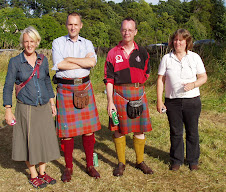So much for
swatching.
Two and a
half rows of the lace pattern I mentioned yesterday, and I saw I couldn’t go
on. The fat nose of the 5mm needle made double-decreasing unpleasant, with the
constant danger of losing one of the three strands. That pattern is nothing but a series of double-decreases, close together. (I’d have spotted the difficulty all
right if I had swatched with the Shibui yarn itself.)
So, guess
what? I’m knitting the pattern as written, in seed stitch. It’s not as bad as I
would have thought, and the resulting fabric – because of those big needles –
is really rather nice. I’m chugging along. I’ll get it done.
The colour
sequence in the pattern as written baffled me last night. We’re knitting with
three strands held together, changing one strand after each 2 ½” stripe. I
started with a stripe of pure A, and have now got as far as the stripe with 2B
and 1A. After the forthcoming pure B stripe, the pattern would have me
re-introduce A.
I was
puzzled. I would expect C. But viewing the problem
with synapses firing this morning, I think the pattern and I will achieve the
same end. They are perhaps expressing it in a Japanese way.
There is no
guidance as to which colours are to be assigned to which letters of the
alphabet. In such a circle, with such a system, using four colours, there will
be two pivot colours which occur only once, and two that repeat, coming and
going. I use A and D as the pivots, they use B and D. We all get there in the
end.
There was a
while, as I struggled with that lace pattern, when I asked myself whether there
may not have been a reason why I resolved never to touch KidSilk Haze again. But now that things have settled down, I’m
enjoying myself. It’s like knitting the cat. I think I may have said that
before.
Sock
I never got
back to the sock yesterday, but now I must finish off that heel so that it can
go in the waiting-room-and-emergencies bag, ready for snatching up.
Maureen, I
must look at the Sweet Tomato again. It was easy when I was doing it – I didn’t
need text at all for the second heel. Now I’m wondering how she manages three
wedges stacked on top of each other, when Gibson-Roberts gets around with one?
By starting with a smaller percentage of the circumference? I’d like to have it
clear in my head.
My husband
has been complaining recently about the sharp angle of a standard heel. One or
the other of these short-rows may be the answer. I look forward to discovering Sherman
Miscellaneous
We haven’t
had much from Zite lately, but here’s
a gem.
Non-knit
We’re
hoping to go to Strathardle this week, Tuesday or Wednesday, far from the
dining room and its problems. According to the calendar, it should be time to
plant potatoes and peas and beans. But the weather forecasts keep going on
about “snow on high ground” (that’s us) and it’s a good general rule of gardening
life that it rarely hurts to wait.




All this colour changing sounds intriguing!
ReplyDeleteI found the Gibson-Roberts book largely incomprehensible - and I would have thought my ability to read knitting patterns was at least average. You are not the first person to have suggested that she over-complicated matters in order to pad out the book. It has been a complaint made by a number of sock knitters I know.
Interesting comment, Jean, on comparing Bordhi's Sweet Tomato heel vs. the Gibson-Roberts heel. So of course I had to go have a look.
ReplyDeleteSweet Tomato: each wedge is worked over 2/3 of the total stitches,working 2 stitches less in each row, & worked until there is ~1 inch of stitches between the turns (paired stitches).
P G-R heel: heel worked over 1/2 of total stitches with 1/5 of total stitches remaining between the YOs when you reach the middle of her heel (changing from shorter & shorter rows to longer & longer rows).
So take a 60 stitch sock, with 8 stitches to the inch.
Sweet Tomato: work heel over 40 stitches with 8 stitches at top of wedge. Work 2+ - 3 wedges. This makes for 32 - 48 rows' worth of heel turn. (That's 2 - 3 wedges at 40 - 8 stitches = 32 & 2 stitches less each row, or 16 rows per wedge.)
P G-R: work heel over 30 stitches, with 12 stitches "unworked" at halfway point of heel. This makes for 36 rows' worth of heel turn. (That's 30 stitches - 12 stitches = 18 & but that only gets you 1/2way thru the heel. You then build back up to 30 stitches 1 stitch per row for another 18 rows.)
So the "typical" Sweet Tomato heel (3 wedges) has ~1/2 again (48) as many rows as the P G-R heel (36) to "make it around the heel" -- thus making it much more rounded. Indeed if you look at the profile of the Sweet Tomato sock (not on a foot) on page 4 of Cat's book, you see that the angle between the leg and the foot is significantly more than 90 degrees.
Sorry for the hijack into geeks-ville -- but that's sort of my thing.
Cheers!